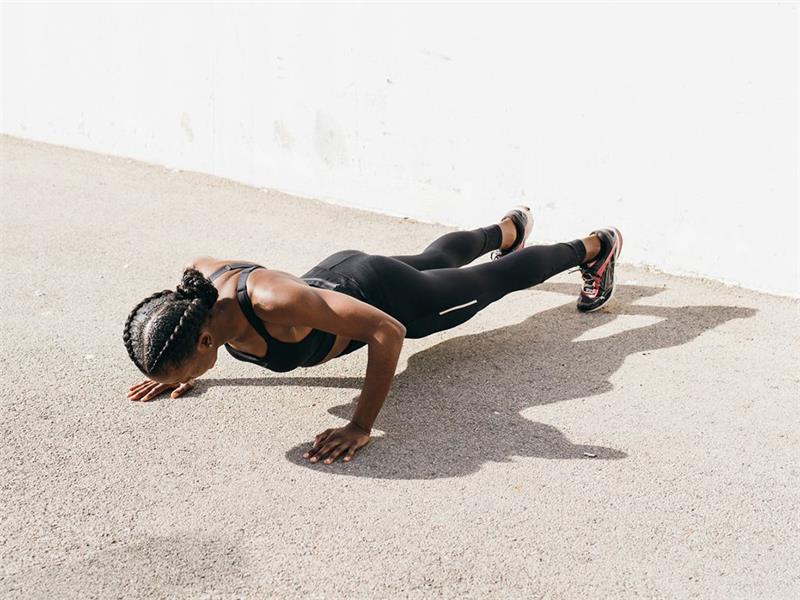Contents
- 1 Introduction
- 2 What is Core Strength?
- 3 Importance of Core Strength for Everyday Life and Physical Activity
- 4 Definition and Explanation of Core Muscles
- 5 Benefits of Having a Strong Core
- 6 Exercises for Strengthening the Core
- 7 Incorporating Yoga or Pilates into Your Fitness Routine
- 8 Engaging in Activities That Require Core Stability
- 9 Small Details That Can Make a Big Difference
- 10 Conclusion:
Introduction
The Power of the Core
When we think of developing strength, we often focus on our arms, legs, and chest. But the truth is that our core muscles are just as important – if not more so – when it comes to overall fitness and health. Our core muscles include everything from our abdominal muscles to our lower back and hips.
These muscles work together to provide stability and support for our entire body during physical activity. But why is having a strong core so important?
For starters, it can help prevent injury by providing better balance and stability during exercise or day-to-day activities. A strong core can also lead to better posture which, in turn, can reduce back pain caused by poor posture or sitting for long periods of time.
Improving Your Core Strength: The Basics
Now that you know how vital a strong core is, let’s dive into some ways you can improve it. There are countless exercises out there that target your core muscles specifically – everything from crunches to planks to squats. However, it’s worth noting that simply doing a few minutes of crunches each day won’t necessarily lead to significant improvements in your core strength.
Instead, think about incorporating a variety of exercises into your routine that targets different muscle groups within your core. This might mean doing some yoga poses that require a lot of balance or trying out Pilates workouts designed specifically for the core.
By mixing up your routine with different exercises, you’ll be challenging your muscles in new ways which will lead to greater improvements in overall strength. Of course, one thing you’ll need to keep in mind when working on your core is patience.
Building up strength takes time – it’s not something you can do overnight or even over the course of a week or two. However, with consistent effort and dedication towards improving your overall fitness levels through proper diet and exercise, you’ll eventually start to see the benefits of a stronger core.
What is Core Strength?
When we talk about “core strength,” we’re not just talking about having visible abs. The core muscles are actually a group of muscles that make up the trunk of your body, including the abdominals, back muscles, and even some of the muscles in your hips and pelvis.
These muscles work together to provide stability and support for everything you do, from sitting at your desk to running a marathon. One of the key components of core strength is having good posture.
When your core muscles are weak or unbalanced, it can lead to poor posture and chronic pain in the neck, shoulders, and lower back. This is because those muscles aren’t able to effectively support your spine and keep it in a neutral position.
Importance of Core Strength for Everyday Life and Physical Activity
Core strength isn’t just important for athletes or fitness enthusiasts – it’s essential for everyone. That’s because our core muscles play a role in virtually every movement we make throughout our day-to-day lives.
For example, when you reach up to grab something off a high shelf or bend down to tie your shoes, you’re engaging your core muscles without even realizing it. And if those muscles are weak or imbalanced, it can be more difficult to perform these movements safely and effectively.
In addition to improving everyday activities like these, having strong core muscles can also improve athletic performance. Whether you’re running a marathon or playing pickup basketball with friends on the weekend, having good core stability can help you achieve better balance and control over your movements – which may ultimately help prevent injuries as well.
Definition and Explanation of Core Muscles
So what exactly are these “core” muscles? As mentioned earlier, they include not just the abdominals but also several other muscle groups that support the spine and trunk:
– Rectus abdominis: This is the muscle group that forms the “six-pack” abs that many people strive for. It runs along the front of your abdomen and helps to flex your spine forward.
– Obliques: There are two sets of oblique muscles – internal and external – that wrap around your torso on either side of your rectus abdominis. They help you twist and bend sideways.
– Transverse abdominis: This muscle group is deeper than the others, located below the obliques. It helps to compress the abdomen and stabilize the spine.
– Erector spinae: These are muscles in your lower back that help to extend (straighten) your spine. – Multifidus: Another set of muscles in your back, these run along either side of your spinal column and also help with stability.
Together, these muscles work to support and stabilize the trunk of your body. By focusing on exercises that engage all of these muscle groups, you can improve overall core strength and stability – which can have a wide range of benefits for both everyday life and physical activity.
Benefits of Having a Strong Core
Improved Posture and Balance
Having a strong core can improve your posture and balance, which is important in everyday life. When your core muscles are engaged, it helps to keep your spine in proper alignment, preventing slouching and other poor posture habits. Additionally, a strong core helps to stabilize your body when you’re standing or walking, reducing the risk of falls or accidents.
Poor posture can lead to a host of problems such as back pain, neck tension, and even headaches. By strengthening the muscles that support your spine, you can help alleviate these symptoms while also looking taller and more confident.
Reduced Risk of Injury
Another benefit of having a strong core is the reduced risk of injury during physical activity or everyday movements. Your core muscles provide stability and support for movements such as bending over to pick up something heavy or twisting to grab something from behind you.
Without sufficient strength in these muscles, you may strain or injure yourself. In sports activities such as running or jumping, having adequate core strength can also help prevent injuries by providing stability for movements that put stress on joints like knees and ankles.
Enhanced Athletic Performance
Athletes who have strong cores tend to perform better than those who don’t. A strong core provides a base of support for many athletic movements such as throwing, kicking, or swinging a bat/racket/golf club, etc. Moreover, athletes with stronger cores generally have better control over their body’s movement.
For example – runners with stronger cores have better form while running which results in faster times and reduced likelihood of injury. Overall improvement in athletic performance leads to increased confidence levels which often translates into higher success rates both on and off the playing field!
Exercises for Strengthening the Core
When it comes to strengthening your core, exercises like planks, crunches, and Russian twists are some of the most effective. Planks are particularly beneficial because they engage all of your core muscles at once.
To perform a plank, start in a push-up position with your arms straight and hands shoulder-width apart. Lower your forearms to the ground so that your elbows are directly under your shoulders.
Hold this position for as long as you can, aiming to increase the amount of time you can hold it each week. Crunches are another popular exercise for strengthening the core.
They target the rectus abdominis muscle (commonly known as the “six-pack”) and can be performed in several variations to target different areas of the abs. One example is bicycle crunches, where you lie on your back with your hands behind your head and alternate bringing each elbow towards opposite knees while also lifting your legs off the ground.
Russian twists are a great exercise for targeting both the abs and obliques. To do this exercise, sit on the ground with knees bent and feet flat on the floor.
Lean back slightly so that you feel the tension in your abs and lift your feet off the floor until your shins are parallel with the ground. Clasp hands together at chest level or hold onto weights if desired (for extra challenge) then twist torso to left side, then right side – this completes one rep.
Incorporating Yoga or Pilates into Your Fitness Routine
Yoga and Pilates both focus heavily on core strength – making them excellent additions to any fitness routine trying to improve overall stability and balance. Pilates exercises often involve small movements that target specific muscles in ways other workouts might not; they frequently use props such as resistance bands or weights during their routines. Yoga is excellent for improving flexibility while still providing strengthening benefits.
Many yoga poses such as the plank, boat pose, and downward dog are great for targeting the core muscles and improving overall stability. Both practices offer classes for all skill levels making it accessible to anyone that is interested in exploring these forms of exercise.
Engaging in Activities That Require Core Stability
Improving your core strength can also extend beyond the gym or studio into real life by engaging in activities that require stability such as swimming or rock climbing. Swimming uses almost every muscle group in your body including your core muscles since they are essential for balancing while swimming. By regularly swimming laps you can improve your overall fitness level and strengthen your entire body – especially the core.
Rock climbing is another activity that requires significant core strength since it involves shifting weight and maintaining balance during ascent. This challenges not only physical strength but also mental fortitude.
Regular practice of rock climbing is a great way to improve your overall fitness level and increase confidence in general athleticism. By incorporating these exercises into a regular routine or through engagement with activities that require core stability, it’s possible to strengthen our abdominal muscles and experience many benefits both physically and mentally!
Common Mistakes When Trying to Improve Core Strength
Relying solely on crunches
Crunches are often the go-to exercise when people think about working their core but relying solely on crunches can be a mistake. While they do work the rectus abdominis muscle (the “six-pack muscles”), they neglect other important muscles in the core such as the obliques, transverse abdominis, and lower back muscles. Neglecting these muscles can lead to imbalance and even injury.
Additionally, doing too many crunches can put unnecessary strain on the neck and spine if not executed properly. It’s important to mix up your core exercises and target all of the different muscle groups in your core for a well-rounded workout.
Neglecting other muscle groups
Another common mistake when trying to improve core strength is neglecting other muscle groups. The core does not work in isolation – it needs support from other muscle groups such as the glutes, hip flexors, and upper back muscles. Neglecting these muscles can also lead to muscular imbalances and potential injury.
To avoid neglecting other muscle groups, incorporate exercises that work multiple areas of your body at once such as planks or mountain climbers. These exercises engage more than just your abs and will help you build a stronger overall foundation.
Not maintaining proper form during exercises
Maintaining proper form during exercises is crucial for targeting the right muscles and avoiding injury. Improper form during exercises like planks or squats can result in strain on your lower back or knees. Before starting any exercise routine, make sure you have the proper form down pat.
Start with lighter weights or modified versions of an exercise until you feel confident enough to increase intensity or difficulty levels. It’s also important to listen to your body – if you feel pain or discomfort during an exercise, stop immediately and reassess your form.
Small Details That Can Make a Big Difference
Breathing techniques during exercises
It’s easy to overlook the importance of breathing when it comes to strengthening your core, but proper breathing can actually help you engage your muscles more effectively. When performing exercises like planks or crunches, inhale deeply and expand your belly as you lower yourself down.
Exhale slowly as you lift yourself back up, engaging your core and focusing on contracting those muscles. This not only helps you maintain control and stability during the exercise but also ensures that you get the most out of each repetition.
But be careful not to hold your breath! Some people tend to hold their breath during difficult exercises, which can actually decrease blood flow and oxygenation to the muscles.
This can lead to fatigue and even dizziness. So remember to breathe deeply and consistently throughout each exercise.
Proper alignment and engagement of muscles
To truly engage your core muscles, it’s important to maintain proper form and alignment during exercises. When performing planks or crunches, for example, make sure that your hips are level with your shoulders and that your spine is in a neutral position. Avoid arching or rounding your back, as this can put unnecessary strain on other areas of the body.
Focus on engaging your deeper core muscles by imagining that you’re pulling them in towards your spine. This will help activate those hard-to-reach muscles like the transverse abdominis for a more effective workout.
Gradually increasing intensity and difficulty
It’s important not to rush into advanced core exercises without first building a solid foundation of strength. Start with basic exercises like planks or bridges before moving on to more challenging variations like side planks or mountain climbers.
As you progress, gradually increase both the intensity (by adding weight or resistance) and difficulty (by performing more reps or holding the position for longer). This will help prevent injury and ensure that you’re making steady progress towards a stronger core.
Remember, it’s not just about doing the most difficult exercises possible – it’s about finding the right balance of challenge and sustainability. By focusing on these small details and gradually building strength over time, you can achieve a stronger, healthier core.
Conclusion:
Core strength is an essential aspect of overall fitness and a healthy lifestyle. By understanding the importance of core strength, you can make a conscious effort to improve it, which will lead to better posture, balance, and physical performance. In this article, we have explored what core strength is, its benefits, and how to improve it through various exercises and activities.
One important point emphasized throughout the article is that core strength isn’t developed overnight or with a magic pill; instead, it requires time and dedication. Consistency in exercise routines combined with patience will help ensure long-term success in developing core strength.
By avoiding common mistakes such as solely relying on crunches without incorporating other muscle groups or neglecting proper form during exercises can help avoid injury. Furthermore, pay close attention to minor details such as breathing techniques during exercises and gradually increasing intensity while maintaining proper alignment and engagement of muscles are all crucial aspects of building up your core muscles over time effectively.
: by incorporating consistent exercise routines that focus on strengthening your core muscles through targeted activities such as yoga or Pilates can be an excellent way to stay engaged while improving your overall health. With persistence comes progress – keep at it!













